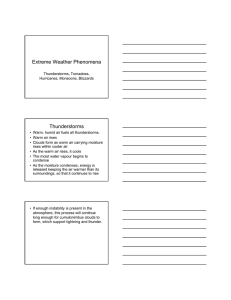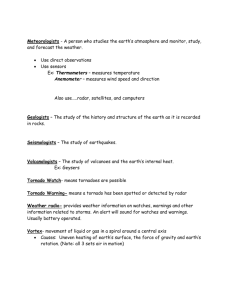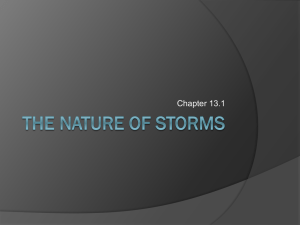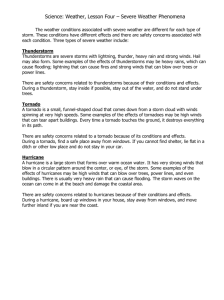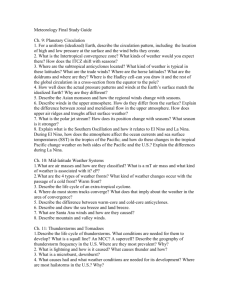Extreme Weather Phenomena Thunderstorms
advertisement
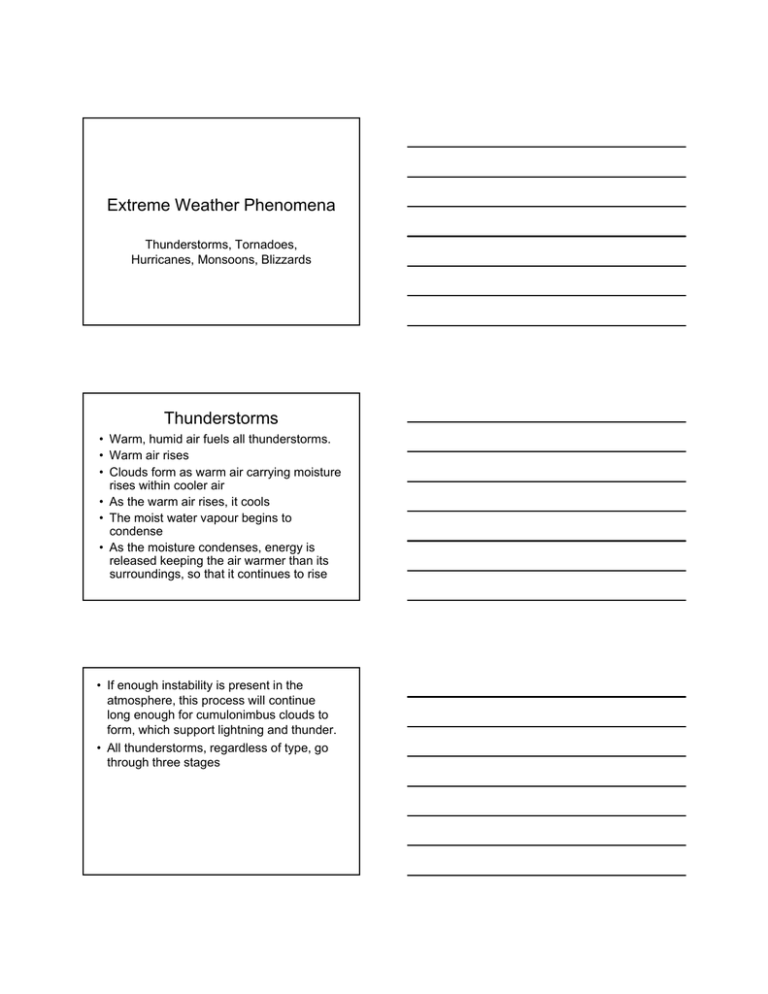
Extreme Weather Phenomena Thunderstorms, Tornadoes, Hurricanes, Monsoons, Blizzards Thunderstorms • Warm, humid air fuels all thunderstorms. • Warm air rises • Clouds form as warm air carrying moisture rises within cooler air • As the warm air rises, it cools • The moist water vapour begins to condense • As the moisture condenses, energy is released keeping the air warmer than its surroundings, so that it continues to rise • If enough instability is present in the atmosphere, this process will continue long enough for cumulonimbus clouds to form, which support lightning and thunder. • All thunderstorms, regardless of type, go through three stages Cumulus (Developing) stage • Moisture is lifted upwards into the atmosphere – A cold front moves in • The moisture rapidly cools into liquid drops of water • Cumulus clouds form Mature Stage • Warm air rises into the cloud and condenses • The condensation releases energy causing it to still be warmer than the surrounding air and thus keeps rising • An updraft is created pulling in more air from below • The water droplets combine and freeze to become ice particles • When they are too heavy they fall • If they melt when they fall we get rain, if not, hail • The falling precipitation cools the air underneath the storm creating a downdraft Dissipating stage • The downdraft has cooled the air so much that the updraft of warm air stops • The rain continues until the supply of moisture has run out • The thunderstorm is over Tornadoes • Tornadoes are the most violent storms on Earth • Winds spiraling into them can vary from 60 km/h to as high as 500 km/h • A tornado is a violently rotating column of air in contact with the ground resulting from a thunderstorm How a Tornado Forms • Tornadoes form in within a thunderstorm's updraft. • Small cyclones of air in the updraft intensify • The air pressure in the center of the cyclone is lower causing it to spin faster and narrower • A funnel cloud appears Intensity of Tornadoes • The Fujita Scale is used to rate the intensity of a tornado by examining the damage caused by the tornado after it has passed over a man-made structure. F-Scale Number Intensity Phrase Wind Speed F0 Gale tornado 40-72 mph Some damage to chimneys; breaks branches off trees; pushes over shallow-rooted trees; damages sign boards. F1 Moderate tornado 73-112 mph The lower limit is the beginning of hurricane wind speed; peels surface off roofs; mobile homes pushed off foundations or overturned; moving autos pushed off the roads; attached garages may be destroyed. F2 Significant tornado Considerable damage. Roofs torn off frame houses; mobile homes 113-157 mph demolished; boxcars pushed over; large trees snapped or uprooted; light object missiles generated. F3 Severe tornado F4 F5 F6 158-206 mph Type of Damage Done Roof and some walls torn off well constructed houses; trains overturned; most trees in fores uprooted Devastating Well-constructed houses leveled; structures with weak foundations 207-260 mph tornado blown off some distance; cars thrown and large missiles generated. Incredible tornado 261-318 mph Strong frame houses lifted off foundations and carried considerable distances to disintegrate; automobile sized missiles fly through the air in excess of 100 meters; trees debarked; steel re-inforced concrete structures badly damaged. These winds are very unlikely. The small area of damage they might produce would probably not be recognizable along with the mess produced by F4 and F5 wind that would surround the F6 winds. Missiles, Inconceivable 319-379 mph such as cars and refrigerators would do serious secondary damage that tornado could not be directly identified as F6 damage. If this level is ever achieved, evidence for it might only be found in some manner of ground swirl pattern, for it may never be identifiable through engineering studies Hurricanes, Typhoons, Tropical Cyclones • Spinning storms formed over the ocean • The main characteristics of a hurricane, are: – Hurricanes have no fronts – Hurricane winds weaken with height – The centers of hurricanes are warmer than their surroundings – Hurricanes and tropical systems form under weak high-altitude winds. – Air sinks at the center of a hurricane – Hurricanes' main energy source is the latent heat of condensation – Hurricanes weaken rapidly over land Classification • Tropical disturbance, tropical wave – Unorganized mass of thunderstorms, very little, if any, organized wind circulation. • Tropical depression – Has evidence of closed wind circulation around a center with sustained winds from 20-34 knots (23-39 mph). • Tropical storm – Maximum sustained winds are from 35-64 knots (4074 mph) • Hurricane or typhoon – Maximum sustained winds exceed 64 knots (74 mph). Monsoon • A system of winds that causes torrential rain and extensive flooding Blizzard • Usually formed when the jet stream dips far to the south, allowing cold air from the north to clash with warm air from the south. • It’s a blizzard if… – heavy falling or blowing snow – winds 40 km/h or more – visibility reduced to less than 400 m – for at least 4 hours
